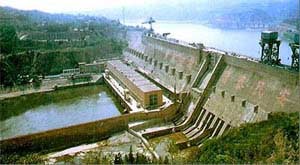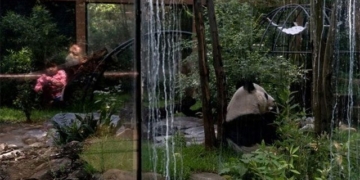If Chinese scientists in the 1950s had dared to speak the truth like irrigation expert Huang Wanli, even if it was ‘contrary to the wishes’ of the leaders, the people living along the banks of the Yellow River would not have had to endure the suffering and hardship caused by the Sanmenxia Reservoir for over half a century (and it remains unclear when it will end).
 |
|
Sanmenxia Dam on the Yellow River. (Photo: Threegorgesprobe) |
In 1952, the Chinese government invited the Soviet Union to assist in establishing a flood control project for the Yellow River, which frequently caused major floods in the country. In October 1954, under the guidance of a Soviet expert team, the Yellow River Planning Committee (primarily composed of the Ministry of Water Resources and the Ministry of Fuel Industry) completed the document: “Comprehensive Utilization Plan for the Yellow River.”
This would be a grand project: along the main course of the river, 46 large dams would be built, with Sanmenxia being the largest; the total electricity generation capacity of these dams was set to be 23 million KW, producing an average of 110 billion kWh annually—ten times the entire electricity output of China in 1954; irrigated land would increase from nearly 17 million Chinese mu to 116 million mu, and 500-ton barges would be able to travel from the East China Sea all the way to Lanzhou.
By September 1960, the Sanmenxia Reservoir was completed. From the second year onward, 800,000 mu of rice fields on both banks of the river were flooded, requiring the relocation of an entire county; the city of Xi’an was severely threatened. Starting in 1972, the Yellow River began to experience a decline in flow. Since 1990, on average, the Yellow River has had more than 100 days annually without water. Hundreds of thousands of Chinese farmers were forced to abandon fertile land in their hometowns to move to barren areas in remote regions, with some being relocated multiple times and losing all their assets. Today, after nearly 50 years, the ecological conditions in the Yellow River basin have deteriorated significantly, with little water remaining in the river downstream.
According to the People’s Daily on February 16, 2005, residents around the reservoir had to relocate their homes twice due to rising waters during the rainy season; 9 out of the past 10 years have been drought-stricken; average incomes are nearly half of the national average, with 297,000 people classified as poor, including 114,000 in absolute poverty; many households have total assets of less than 20 USD. In summary, farmers have suffered greatly due to this hydropower and irrigation project. When a senior government delegation visited the area, everyone cried and expressed that the government had truly wronged the people.
Irrigation engineer Wang Dui Le, who resides in Germany, stated in his article “40 Years After the Completion of the Sanmenxia Project” that the cost of this project was equivalent to the construction of 40 bridges on the Yangtze River in Wuhan; the subsequent renovation costs and the economic losses caused by this project to large regions were incalculable.
Chinese people would not have had to endure these consequences if they had listened to and heeded the opinions of the renowned irrigation scientist Huang Wanli—Professor at Tsinghua University. Of course, when the government proposed the construction of the Sanmenxia irrigation project, he was one of the first to participate.
From the very beginning, Huang Wanli stated: the Soviet Union had much experience in building hydropower plants, but they did not understand the issues of the Yellow River. Unlike rivers in the Soviet Union, the Yellow River carries a high amount of sediment, which would later become the source of disaster. However, at that time, both experts and leaders followed the opinions of the Soviet specialists (despite the fact that this expert team was composed entirely of civil engineering specialists, rather than irrigation experts). State leaders were even more united in their dream of “When the sage appears, the Yellow River will be clear.” In such an extreme and one-sided atmosphere, responsible experts of the project dared not persist in their views and excessively praised the plan proposed by the specialists. Only Huang Wanli had the courage to publicly oppose this project. He stated: “I say the Yellow River cannot be clear. A clear Yellow River is not a benefit, but a disaster.”
On June 10, 1957, a conference discussing the Sanmenxia irrigation project was held in Beijing, at which point the project had already begun preparations for construction. A heated debate took place at the conference between those in favor of and against the design proposed by the Soviets and Huang Wanli. Supporters painted a grand picture: building high dams, blocking floodwaters, trapping sediment, and ensuring that the water flowing out of the reservoir would be clear and free of sediment. Huang Wanli argued that if a dam were built on a sediment-laden section of the river, then the flooding downstream would be transferred to the middle reaches. He believed that the sediment in the river water naturally divides the upstream and creates a delta in the downstream. Building a dam to make the water “clear” is against natural laws; moreover, clear water flowing out of the reservoir is not beneficial for the river downstream. He stated that after the dam was built, fields would be flooded, causing damage to nearby cities.
The debate lasted for seven days, and the majority of experts agreed with the Soviet design. Professor Huang Wanli had to propose: if the dam had to be built, the six drainage tunnels should not be sealed so that pipes could be installed later to discharge sediment. This viewpoint was approved by the entire conference. However, during construction, the Soviet specialists retained the original closed design of all six drainage tunnels. In the 1970s, China had to spend 1.2 million USD to reopen these tunnels.
Sanmenxia has become a valuable lesson for all leaders who do not truly respect science and democracy. On the other hand, scientists must also understand how their lack of honesty can lead to significant disasters.
The Yellow River is the second-largest river in China, stretching over 5,400 kilometers, originating from northern Qinghai Province, flowing through various provinces before emptying into the Bohai Sea in Shandong Province. The Yellow River basin covers more than 752,000 square kilometers and is the cradle of ancient Chinese civilization. The Yellow River flows through the Loess Plateau (yellow soil), with an average elevation of 1,000-2,000 meters, characterized by fast-flowing water that also carries a high concentration of sediment. In the lower reaches, as the river enters the plain, the water flow slows, allowing sediment to settle, raising the riverbed higher than the banks, forming a “river on land.” Due to these characteristics, during the rainy season, the Yellow River frequently causes floods, resulting in many catastrophic disasters in history, such as the flood in 1937 that killed 3.7 million people and caused incalculable economic damage.


















































